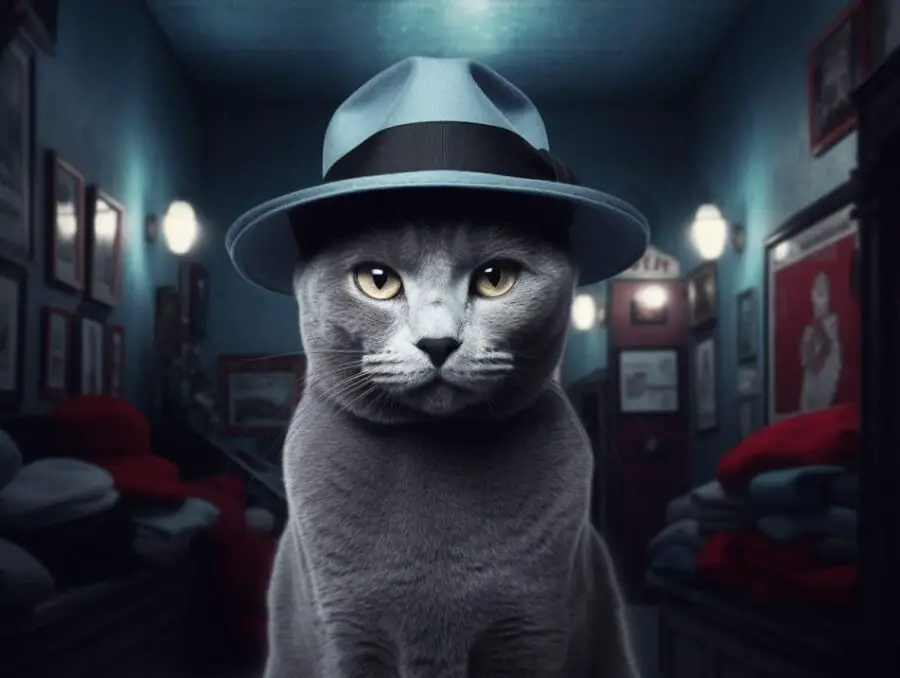Have you ever heard a tale where a simple cat becomes the center of a Cold War espionage mystery? Well, brace yourself because the story of Mishka, a Russian Blue cat, is just as intriguing and unexpected as it sounds.
Back in 1951, this unassuming critter found himself in the thick of international intrigue, sparking rumors and raising eyebrows in the highest echelons of global diplomacy.
This wasn’t your typical feline frolic. No, Mishka’s knack for vanishing and then reappearing at the US embassy in Moscow led many to suspect that he was more than just a curious cat.
So, was this Russian Blue really a Cold War spy, or was he just enjoying the extra attention from the diplomats?
Let’s unravel the uncanny story of Mishka, a tale that blurs the lines between reality and fable, taking us on a journey through the fog of Cold War paranoia and suspicions.
Get ready for a tale that’s sure to curl your whiskers!
The Enigmatic Story of Mishka the Russian Blue Cat
Once upon a time, in the heart of Moscow, a seemingly ordinary Russian Blue cat named Mishka began to make extraordinary moves.
He developed an intriguing habit of disappearing for days, only to suddenly reappear within the US embassy’s grounds.
This curious pattern caught the attention of both American and Russian officials, leading to a whirlwind of speculations that Mishka might be involved in something far bigger than any cat’s play.
Cold War Context: Understanding the Paranoia of the 1950s
To fully appreciate Mishka’s story, we need to travel back in time to the 1950s – an era marked by suspicion, secrecy, and spycraft.
The Cold War, a period of political and military tension between the Western and Eastern blocs, was in full swing. This was way bigger than modern-day cyber threats.
Every move was scrutinized, every coincidence questioned. In this atmosphere, even the actions of a seemingly harmless cat could be seen as a possible ploy in the clandestine game of nations.
The Mysterious Disappearances and Appearances of Mishka
Mishka was no ordinary cat, not just because of his sleek coat and mesmerizing green eyes.
It was his unexplained disappearances and sudden reappearances that made him extraordinary.
Mishka would vanish from sight, only to show up days later at the US embassy.
Some began to wonder if this was just feline fancy, or was Mishka smuggling secrets to and from the embassy under the cover of his fluffy charm?
Mishka: The Russian Blue Cat Suspected of Espionage
As the whispers around Mishka grew louder, so did the theory that he wasn’t merely a lost cat finding comfort in the embassy.
Rather, some started to suspect Mishka of espionage.
Was it possible that this Russian Blue, with his disappearing acts, was a spy in disguise?
Was Mishka using his nine lives for undercover operations during one of the most tense periods in global history?
The questions were many, and answers were hard to come by.
The Cat in the Cold War: Unusual Suspects and Counterintelligence
In the dizzying world of Cold War espionage, it wasn’t unheard of for suspicions to fall on the unlikely.
Codes were hidden in everything from a hollowed-out coin to a game of chess. In this universe of secrets and shadows, Mishka’s routine of vanishing and reappearing had folks thinking – could a cat be a part of this murky world?
It sounds unbelievable, but remember, this was a time when nothing was off the table when it came to spy tactics.
US Embassy in Moscow: A Stage for Feline Espionage?
The US embassy in Moscow became Mishka’s favorite haunt, a place where he was often spotted after his mysterious absences.
The embassy was already a place of intrigue and secrets, and Mishka’s frequent visits only added to the drama.
Could the grounds of this highly secure location have unwittingly become a stage for feline espionage?
Or was Mishka simply drawn to the warm radiators and friendly embassy staff?
Mishka’s Unusual Habits and Their Implications during the Cold War
If you’ve ever owned a cat, you’d know that they are creatures of habit with a love for routine. But Mishka was far from conventional in his habits, a trait that led to some remarkable conjectures during the tense Cold War period.
Mishka had an unusual pattern of disappearing for days at a time, only to pop up again at the US embassy in Moscow. This uncanny ability to vanish and reappear as if by magic was initially viewed as mere feline eccentricity.
But as the Cold War tensions escalated, the implications of Mishka’s habits took on a new gravity.
Every unexplained absence was viewed as a potential mission, and each reappearance was seen as the return of a covert operative with possible secrets.
Was Mishka simply lost and found his way back each time, or was he whisking away classified information unnoticed?
Could he have been trained to sniff out secrets or transport tiny microfilms, or was he merely exploring his surroundings out of pure feline curiosity?
The Cold War was an era when the ordinary became extraordinary, and the harmless could appear dangerous.
This was the lens through which Mishka’s unusual habits were viewed. Was he a spy cleverly disguised as a friendly feline, or was he just an adventurous cat oblivious to the political storm brewing around him?
The implications of Mishka’s habits became a topic of hushed discussions in both American and Russian intelligence circles. Each disappearance fueled suspicion, and every reappearance reinforced the theory of Mishka being a furry undercover agent.
It was a time when nothing seemed too far-fetched, not even a feline spy in the midst of a geopolitical showdown.
Cross-Species Espionage: A Rare Phenomenon in Cold War History
While it sounds like a plot from a high-octane spy novel, the concept of using animals in espionage isn’t entirely far-fetched.
Just read about Operation Acoustic Kitty, the CIA’s audacious plan to spy on Russia using cats. This story will leave you reeling.
During the Cold War, both sides explored unique and innovative methods for gathering intelligence.
Carrier pigeons, trained dolphins, and even spy bugs were used.
However, a cat spy like Mishka was truly one for the books. His story reminds us of the lengths to which paranoia and suspicion can lead, even if it means suspecting our furry friends!
Final Verdict: Was Mishka Really a Spy or Just an Innocent Cat?
Whether Mishka was a genuine, four-legged spy or a mischievous cat with a love for diplomatic grounds is still shrouded in mystery.
Despite the swirling rumors and suspicions, no solid evidence was ever found to pin Mishka as a covert agent.
Maybe he was just a curious cat who liked exploring the embassy grounds, or maybe he was indeed the James Bond of the feline world.
We might never know, but it’s certainly fun to imagine the possibilities.
Mishka’s Legacy: How a Cat Stirred Cold War Suspicions
Even though the Cold War has long since ended, stories like Mishka’s continue to add intrigue and charm to this intense period of history.
The tale of Mishka, the Russian Blue cat suspected of being a spy, is a testament to the height of suspicions during those times.
Even though we’ll never definitively know whether Mishka was part of a larger game of espionage, his story remains a captivating anecdote in the annals of Cold War lore.
"In ancient times cats were worshipped as gods; they have not forgotten this."
-- Terry Pratchett





